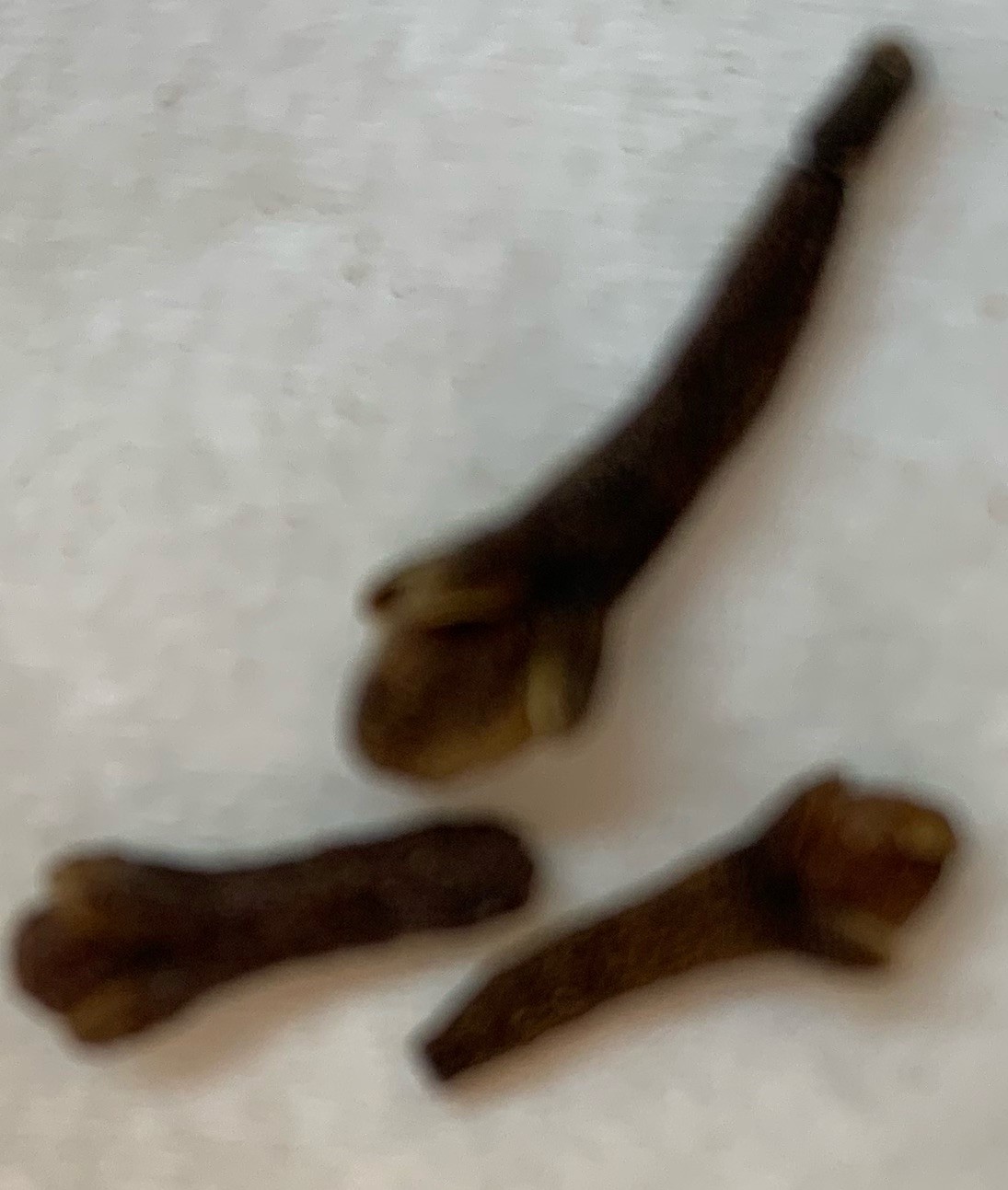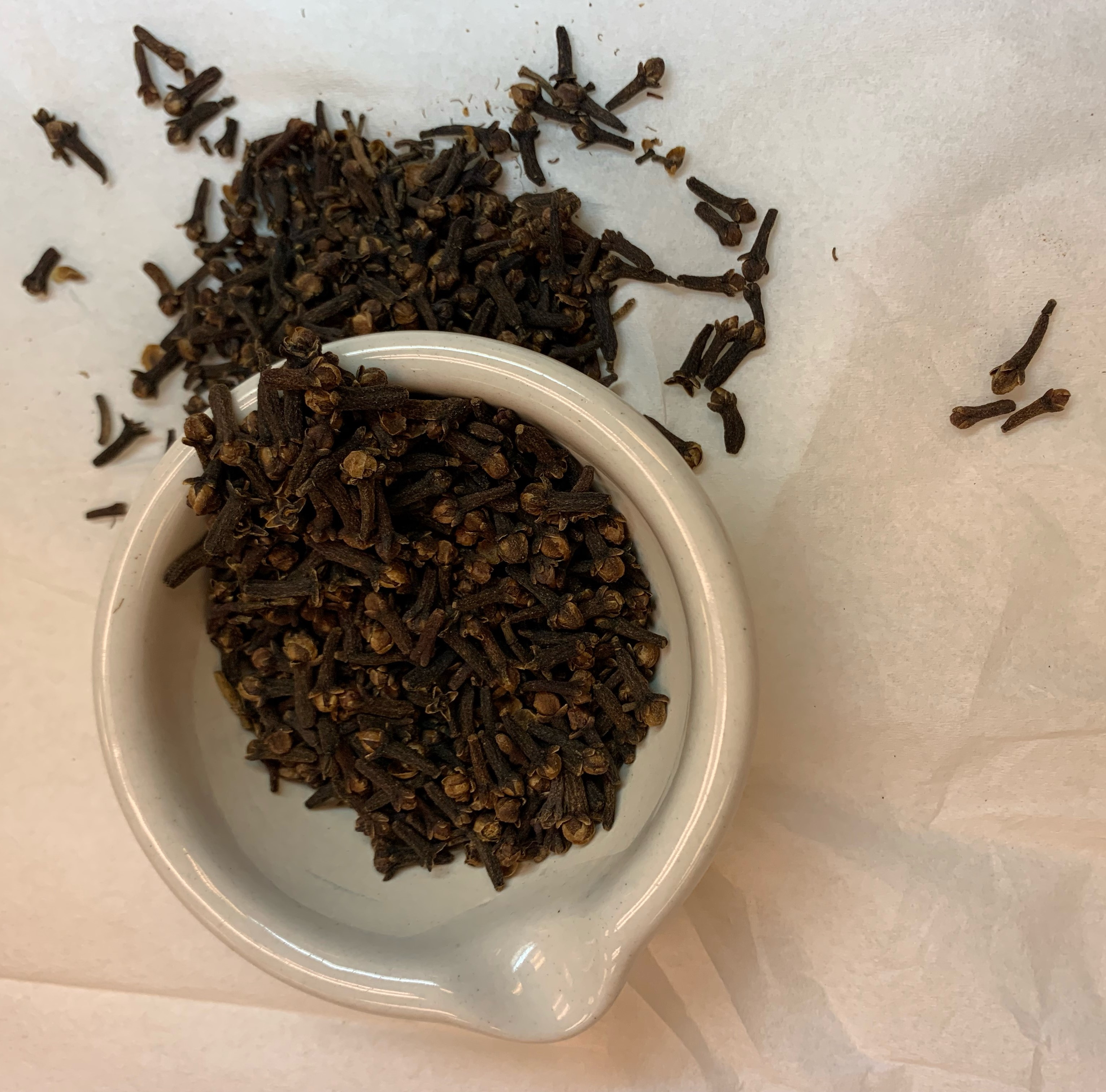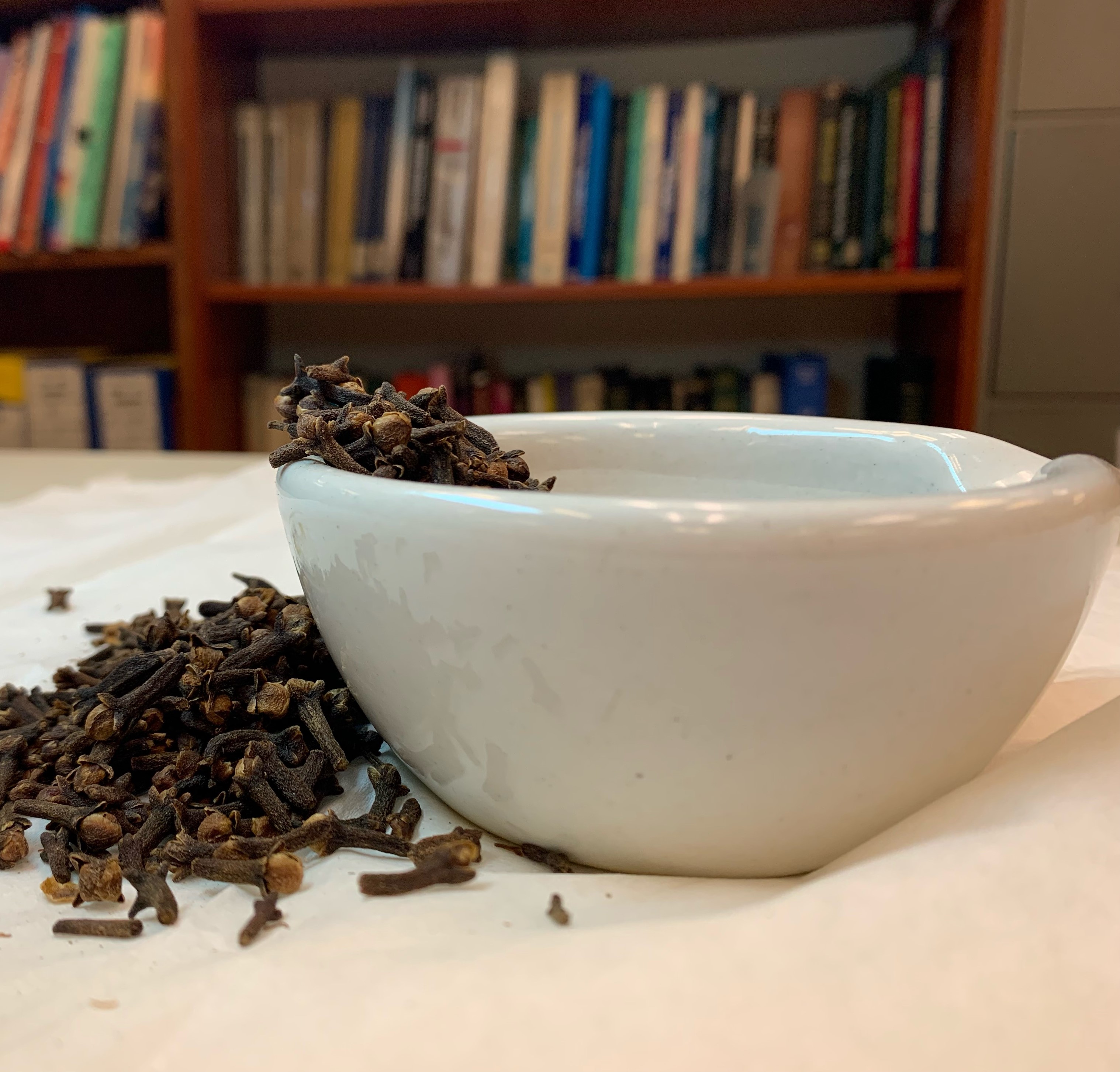
Clove Flower Heads.
Of cloves discovered earliest of all
Within that garden where such seed takes root;

Joseph Thottungal
Hi my name is Joseph Thottungal: I am an undergraduate student entering my second year of biomedical studies at the University of Ottawa. I am passionate about chemistry, biology and medicine. Lab experiences allow me to explore the efficiency of theory and how theory in textbooks becomes crytsallized in the real world.
Our group is working on hydrosols of many raw materials and analyzing the compounds within them using gas chromatography mass spectrometry. This project will hopefully provide us with helpful information on many spices and fresh plants: and how many natural materials can be beneficial for maintaining proper physical and mental health
Summer 2022.
Joseph, prepared and analysed clove buds, in May 2022. A sample was placed in the freezer.

I am Serena Bezanson, a Co-op student in the J. L. Holmes Mass Spectrometry facility. I’m an undergraduate student in my second year in Biochemistry at the University of Ottawa. In this exciting laboratory, I gained an understanding of how GC-MS can aid in analyzing the chemical make-up of various samples. Practically, I was able to use this technique to compare the composition of the essential oil from cloves and its hydrosol. From this analysis, I cross referenced literature to determine the therapeutic effects of the active ingredient Eugenol found in the hydrosol. I also look forward to using the techniques I’ve learned to analyze a sample from the tree Pleodendron costaricense.

The plant Syzygium aromaticum, also known as cloves, has been historically used as a flavouring in food and as a perfume due to its highly aromatic and volatile compounds. During the Handynasty, the spice had to be held in the speaker’s mouth to perfume their breath in order for them to have an audience with the emperor (Clove | Description, History, & Uses | Britannica, n.d.). There is also record of clove trees being planted symbolically by people on the Moluccas islands when a child is born (Institute, n.d.). Later this plant played a vital role in the trade routes of European countries in the 18th century. As the Dutch created a financially beneficial scarcity of the clove spice by ruining crops on all but two islands in Indonesia. This decrease in production lasted until the French formed a smuggling operation, bringing cloves to other islands of Indonesia to break Dutch control on the spice. Currently, the clove tree is cultivated in Indonesia, Madagascar, Tanzania, and Sri Lanka.

Cloves have been used in the cuisine of various countries in Asia, Africa, the Mediterranean, and the Middle East. Especially common is the use of cloves in flavouring meats. This not only flavoured the meats but has been shown in a recent study to have preserved raw meat as well (Mh, 2018). The uses of cloves go beyond the realm of the culinary arts. The faculty of furniture design and wood engineering at the University of Brașov have shown clove’s potential in preserving wood against fungus that could ruin historic wood at cultural sites (Pop et al., 2022). Additionally, clove has been shown to be an effective mosquito repellant for up to 4 hours (Sellamuthu, 2014). It has been used in folk medicine as an herbal remedy to cure a variety of ailments such as toothache, indigestion and diarrhea (El-Mesallamy et al., 2012). In many cultures clove oil was often used as an energizing or warming remedy. Specifically in tropical Asia clove has been used effectively to treat disease caused by bacteria and other microorganisms such as malaria, cholera, and tuberculosis (El-Saber Batiha et al., 2020). In current day research into the active compound in cloves, shows the promising health benefits of clove. Essential oil and hydrosol produced from clove buds contain high levels of eugenol. This active ingredient has possible analgesic, anti-inflammatory, and anticoagulant therapeutic properties (Tisserand and Young 2014;Daniel et al., 2009). The analgesic effect can be achieved through a spinal injection or through an oral dose (Daniel et al., 2009). Eugenol can also work as an antibacterial compound and has been shown to be effective against Neisseria gonorrhoeae, MRSA, and MSSA (Shokeen et al., 2008; Yadav et al., 2015). According to Tisserand and Young (2014) it also acts as an antidepressant, since Eugenol can be an enzyme inhibitor against the enzyme monoamine oxidase which breaks apart hormones like serotonin. Additionally, eugenol was found to have antifungal properties. At a concentration of 0.02% the eugenol inhibited growth of Trichophyton mentagrophytes, T. rubrum and Microsporum gypseum (Park et al., 2007). Eugenol has also shown in vitro and in vivo applications as an antioxidant which could protect tissues against free radical damage (Nagababu et al., 2010).

References.
Clove | Description, History, & Uses | Britannica. (n.d.). Retrieved May 4, 2023, from https://www.britannica.com/plant/clove Daniel, A. N., Sartoretto, S. M., Schmidt, G., Caparroz-Assef, S. M., Bersani-Amado, C. A., & Cuman, R. K. N. (2009). Anti-inflammatory and antinociceptive activities A of eugenol essential oil in experimental animal models. Revista Brasileira de Farmacognosia, 19, 212–217. https://doi.org/10.1590/S0102-695X2009000200006 El-Mesallamy, A. M. D., El-Gerby, M., Azim, M. H. M. A. E., & Awad, A. (2012). Antioxidant, Antimicrobial Activities and Volatile Constituents of Clove Flower Buds Oil. Journal of Essential Oil Bearing Plants, 15(6), 900–907. https://doi.org/10.1080/0972060X.2012.10662592 El-Saber Batiha, G., Alkazmi, L. M., Wasef, L. G., Beshbishy, A. M., Nadwa, E. H., & Rashwan, E. K. (2020). Syzygium aromaticum L. (Myrtaceae): Traditional Uses, Bioactive Chemical Constituents, Pharmacological and Toxicological Activities. Biomolecules, 10(2), 202. https://doi.org/10.3390/biom10020202 Institute, M. S. (n.d.). Cloves. McCormick Science Institute. Retrieved May 4, 2023, from https://www.mccormickscienceinstitute.com/resources/culinary-spices/herbs-spices/cloves Mh, T. (2018). Effect of Clove Powder and Garlic Paste on Quality and Safety of Raw Chicken Meat at Refrigerated Storage. 1. Nagababu, E., Rifkind, J. M., Boindala, S., & Nakka, L. (2010). Assessment of antioxidant activity of eugenol in vitro and in vivo. Methods in Molecular Biology (Clifton, N.J.), 610, 165–180. https://doi.org/10.1007/978-1-60327-029-8_10 Park, M.-J., Gwak, K.-S., Yang, I., Choi, W.-S., Jo, H.-J., Chang, J.-W., Jeung, E.-B., & Choi, I.-G. (2007). Antifungal activities of the essential oils in Syzygium aromaticum (L.) Merr. Et Perry and Leptospermum petersonii Bailey and their constituents against various dermatophytes. Journal of Microbiology (Seoul, Korea), 45(5), 460–465. Pop, D.-M., Timar, M. C., Varodi, A. M., Beldean, E. C., Pop, D.-M., Timar, M. C., Varodi, A. M., & Beldean, E. C. (2022). An evaluation of clove (Eugenia caryophyllata) essential oil as a potential alternative antifungal wood protection system for cultural heritage conservation. Maderas. Ciencia y Tecnología, 24. https://doi.org/10.4067/s0718-221x2022000100411 Sellamuthu, R. (2014). Eugenol. In P. Wexler (Ed.), Encyclopedia of Toxicology (Third Edition) (pp. 539– 541). Academic Press. https://doi.org/10.1016/B978-0-12-386454-3.01125-8 Shokeen, P., Bala, M., Singh, M., & Tandon, V. (2008). In vitro activity of eugenol, an active component from Ocimum sanctum, against multiresistant and susceptible strains of Neisseria gonorrhoeae. International Journal of Antimicrobial Agents, 32(2), 174–179. https://doi.org/10.1016/j.ijantimicag.2008.03.018 Yadav, M. K., Chae, S.-W., Im, G. J., Chung, J.-W., & Song, J.-J. (2015). Eugenol: A phyto-compound effective against methicillin-resistant and methicillin-sensitive Staphylococcus aureus clinical strain biofilms. PloS One, 10(3), e0119564. https://doi.org/10.1371/journal.pone.011956

Eugenia caryophyllata, clove, is rich in eugenol and eugenol acetate.
To access whether the hydrosol is robust meaning it's chemical components are stable over time, we re-analysed a sample that had been frozen for one year!
The amount of eugenol was uncompromised but the eugenol acetate had significantly dropped.
In the original sample caryophyllene, a sesquiterpene was also recorded. This has completely disappeared from the frozen sample.
Carophyllene is a non polar molecule and would not dissolve in the water distillate, it is likely part of the essential oil and was on the surface of the water where it could evaporate off easily.